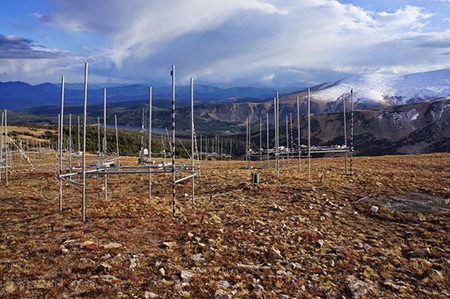By Dan Krotz, Lawrence Berkeley National Laboratory
Scientists expect subalpine trees to advance upslope as global temperatures increase, following their climate up the mountains.
But new research published Dec. 15 in the journal Global Change Biology suggests this might not hold true for two subalpine tree species of western North America.
 A study led by project scientist Lara Kueppers, affiliated with the Sierra Nevada Research Institute, shows Engelmann spruce might not move to higher elevations as temperatures rise. Its lower-elevation boundary could recede upslope, so its overall range could shrink. And the hardy limber pine could advance upward in a warmer climate, but likely at the same slow pace as in today’s climate.
A study led by project scientist Lara Kueppers, affiliated with the Sierra Nevada Research Institute, shows Engelmann spruce might not move to higher elevations as temperatures rise. Its lower-elevation boundary could recede upslope, so its overall range could shrink. And the hardy limber pine could advance upward in a warmer climate, but likely at the same slow pace as in today’s climate.
Researchers at the Department of Energy’s Lawrence Berkeley National Laboratory (Berkeley Lab), UC Merced, the U.S. Geological Survey, UC Berkeley and the University of Colorado at Boulder conducted the study between 2009 and 2014 in Colorado’s Rocky Mountains.
Their surprising findings are based on the discovery that the two species can be harmed by warming during the earliest stages of their lives, even at the cold, high-elevation edge of forest growth. In addition, seeds from trees now growing at the upper boundary of the species’ range might not fare well at higher elevations.
These insights could help scientists improve models that predict where and how fast subalpine forests will move in a warming climate. Scientists are interested in predicting what will happen to subalpine forests as the climate warms because a shift in the boundary between forest and alpine tundra biomes means big implications for mountain water resources, the carbon cycle and the planet’s climate.
“This means there’s a real risk that climate change may outpace tree migration—some trees may not be able to keep up with their climate,” said Kueppers, a former UC Merced faculty member who now works in Berkeley Lab’s Climate and Ecosystem Sciences Division. “Seedlings are the future of the forest, so it’s very important to learn how warming will affect them.
“The assumption that trees will track their climate underestimates the challenges they face during seedling recruitment,” she added. “The odds are stacked against trees at this stage, even under normal conditions, and we found that warming decreases the young trees’ odds of survival even more.”
The scientists focused on the impacts of warming on the first four years of the trees’ lives. They planted the seeds at three sites, one at the low-elevation edge of subalpine forest, another at the high-elevation edge of the forest (the current tree line), and a third site in the alpine zone where the trees don’t grow.
At each site, they planted 20 gardens divided into four groups. One group was heated from March to November with infrared heaters. This melted the snow early and raised the temperatures of soil and seedlings by several degrees, mimicking the effects of climate change.
A second group was heated and watered, a third group was only watered and a fourth control group was left untouched.
Counter to expectations, they found warming reduced seedling survival for both species at all three elevations during the first year of life. The scientists expected survival rates to dip at the lower-elevation site, where temperatures rose above the trees’ normal climate, but not higher up, where warming was expected to help seedlings. They attribute this lower survival rate to drier conditions caused by warming, which negatively affected seedling survival.
Survival rates diverged for the two species after the first year. For the limber pine, the scientists found some benefits of warming at some sites, but not enough to reverse the negative effects from the first year. After four years, there wasn’t a measurable effect of warming on survival.
“From this, we infer that limber pine has the potential to persist at its current location and expand upslope into the alpine zone, but it won’t expand any faster in a warmer climate,” says Kueppers.
Negative effects of warming persisted through the fourth year of the Engelmann spruce, though. No warmed seedlings survived to be 4 years old at the low-elevation site, indicating warming could impede the species’ upward expansion cause the lower-elevation edge of its range to contract upslope.
In another surprise, the scientists found that seeds collected from lower elevations survived better in the alpine zone than seeds collected from higher elevations. This, too, could slow the upslope expansion of subalpine trees, as it’s hard for lower-elevation seeds to “leapfrog” over higher-elevation trees and establish themselves above the current tree line.
“Overall, our findings indicate that seedlings are highly vulnerable to climate variation, which should be taken into account as we predict what will happen to subalpine forests in a warming climate,” Kueppers said.



